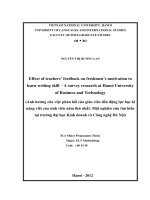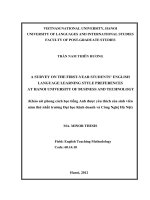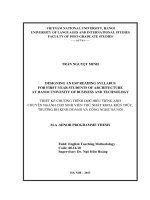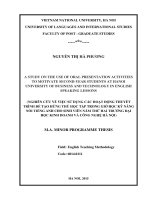Towards designing a translation syllabus for third-year English majors at Hanoi University of Business and Technology
Bạn đang xem bản rút gọn của tài liệu. Xem và tải ngay bản đầy đủ của tài liệu tại đây (274.04 KB, 10 trang )
Towards designing a translation syllabus for
third-year English majors at Hanoi University
of Business and Technology
Trần Thị Phương Chi
Trường Đại học Ngoại Ngữ
Luận văn ThS. Chuyên ngành: English Linguistics; Mã số: 60 22 15
Người hướng dẫn: M.A. Đỗ Minh Hoàng
Năm bảo vệ: 2010
Abstract: This study was conducted to design a syllabus for third-year English majors at Hanoi
University of Business and Technology (HUBT). The proposed syllabus aims at enhancing the
students’ translation skills and translation-related skills. The students are exposed to theoretical
knowledge and practice of translation in both directions. The course adopts a process-based approach
which focuses on stages of the translation process and opts for a communicative, interactive
methodology that focuses on workshop-like activities, pair works, meeting experts, with translating
activities around the students’ selection of business topics. In other words, a student-centered
approach is adopted. The study is expected to offer a career-oriented training program for third-year
English majors.
Keywords: Chương trình giảng dạy; Tiếng Anh chuyên ngành; Dịch
Content:
TABLE OF CONTENTS
CANDIDATE’S STATEMENT i
ACKNOWLEDGEMENTS ii
ABSTRACT iii
LIST OF ABBREVIATIONS iv
APPENDICES ……………………………………………………………………………………………… v
PART A: INTRODUCTION 1
1. Rationale 1
2. Aim of the study 2
3. Research questions 2
4. Scope of the study 2
5. Significance of the study 2
6. Content of the study 3
PART B: DEVELOPMENT 4
Chapter 1: Literature Review 4
1.1. Syllabus in language teaching 4
1.1.1. Definition 4
1.1.2. Types of syllabuses 5
1.2. Translation 7
1.2.1. Definition of translation 7
1.2.2. Translation in teaching 8
1.2.2.1. Grammar-based syllabus 8
1.2.2.2. Task-based syllabus (Constructivism) 9
1.2.2.3. Topic-based syllabus 9
1.2.2.4. Text-based syllabus 10
1.2.2.5. Combined syllabus 10
1.2.2.6. Skills 11
1.2.2.7. Directionality 12
1.2.3. Types of translation in translation pedagogy 14
1.2.4. What is happening in other universities 14
1.2.4.1. General situation 14
1.2.4.2. Examples 15
1.2.4.3. Summary 19
1.3. Needs analysis 20
Chapter 2: Methodology 21
2.1. Data collection instruments 21
2.1.1. Structure of the questionnaire 21
2.1.2. Structure of Interviews with the teachers 22
2.2. Subjects of the study 22
2.3. Data collection procedures 22
2.3.1. Questionnaire 22
2.3.2 Interviews with the teachers 23
Chapter 3: Results and Discussion 24
3.1. Questionnaire 24
3.1.1. Learners’ background 24
3.1.2. Target needs 24
3.1.3. Learning needs 28
3.2. Interviews 31
3.2.1. The teachers’ background 31
3.2.2. The teachers’ comments 31
3.2.3. Suggestions 32
3.3. Summary 32
Chapter 4: The proposed translation syllabus 34
4.1. Introduction 34
4.2. The aims and objectives of the translation course. 34
4.3. Choosing the translation content 35
4.3.1. The integration of translation theory 35
4.3.1.1. Introduction to History of translation 35
4.3.1.2. Introduction to Translation 36
4.3.1.3. Translation Methods 36
4.3.1.4. Text analysis 36
4.3.2. Grading content 37
4.4. Tasks and activities in the year 37
4.5. A proposed translation syllabus for third-year English majors at Hanoi University of
Business and Technology 38
4.6. Sample translation lesson (Appendix 8) 42
Part C: CONCLUSION 43
1. Summary 43
2. Recommendations for further research 44
References 45
1
PART A: INTRODUCTION
1. Rationale
It is without doubt the economic changes all around the world have honestly affected the
language translation service and these days translators are equally involved in every part of
intercultural and business communication. In a world globalization, today language translation
service is becoming a more significant factor for concise transfer of ideas. Translation has
previously been regarded as an art or a craft; now translation scholars are happy to have their
activity recognized as a science and admitted to the inner circle of scholarly pursuits as a
branch of applied linguistics.
Educating English majors to fluently use the foreign language after an undergraduate course is
a becoming an ever important task now in Vietnam when we integrate more deeply into the
world’s economy. One of the jobs graduates can do is to work as translators or interpreters in a
professional manner. How can educational institutions make sure that their graduates can
adapt themselves to the market changes? Therefore, gaining an insight into target needs and
learning needs so as to develop a translation syllabus is an urgent task. I myself, as the
researcher, would like to try to build up a translation syllabus which is helpful for teachers and
meets with the desires of the learners.
In the process of teaching translation the students, it seems that our current syllabus does not
quite meet the learners’ needs and what the instructors want them to learn during the course.
There are different opinions among the teachers about the content of the course. At least the
syllabus should give teachers and learners a direction of what to be taught and how to be
taught. Both the teachers and students have complained about the time available for the
learning of skills in the first and second years. This is the time when acquisition of English
skills is so important to be used as the foundation for the third year when more time is spent
on translation practice.
As for the students, they are not proficient in the 4 skills after the first two years. This has led
to the fact that they meet some difficulties in learning translation and interpreting. Besides, it
2
seems that theoretical backgrounds as well as the methodology have not been paid much
attention to.
Another point is that the researcher sees that little time is spent on teaching students
translation-related skills such as the use of computers as a tool for would-be translators and
interpreters. Ulrych (2005) in her paper asserts that technological aids improve translators’
status and self image.
2. Aim of the study
The study is aimed to identify the needs, wants and lacks of the third-year English majors and
expectation of trainers or course designers so that the researcher can use them as the
foundation for putting forward an appropriate syllabus including content, method of teaching,
time. To achieve the aim, a needs analysis was done to find out the target needs and learning
needs of the students.
3. Research questions
1. What are the learning needs of the third-year English majors?
2. What are the target needs of the third-year English majors?
3. How should the proposed syllabus meet these needs?
4. Scope of the study
The study is done based on the circumstance for third-year English majors at Hanoi University
of Business and Technology (HUBT). Due to the size of the thesis, this is aimed at designing a
written translation syllabus for them (an oral translation syllabus is therefore not within the
scope of this thesis).
5. Significance of the study
This is aimed at making learning of translation more efficient in terms of learners’ desires,
trainers’ objectives based on the learning needs and target needs. Theoretically, this will help
provide teachers with basic knowledge of syllabus design in general and translation syllabus
design in particular. Hopefully, this syllabus will give teachers as well as students the profile
of what and how should be taught and learnt in order to achieve the course’s objectives.
3
6. Content of the study
Part A: Introduction is aimed at providing the background, rationale, the aims, research
questions and significance of the study.
Part B: Development
Chapter 1 Literature Review reviews the literature of syllabus design, translation teaching
and translation syllabus.
The first part is about syllabus design and types of syllabi which are used as a base for
designing the proposed syllabus. The second part taps into translation in terms of definition,
types of translation syllabi, types of translation and the training situations in some European
and Asian countries. From the situation, the researcher may apply some good ways in
designing the proposed syllabus.
The last part will provide some facts about The English Department, Hanoi University of
Business and Technology.
Chapter 2: Methodology deals with methodologies of collecting data.
Chapter 3: Results and Discussion consists of an analysis of a post-course questionnaire, a
semi-structured interview with the translation teachers.
Chapter 4: The Proposed Translation Syllabus is devoted to the proposed translation
syllabus including the aims, objectives of the translation course, the translation content, tasks
and activities, the proposed syllabus and a sample translation lesson.
Part C: Conclusion and Recommendations
This chapter summarizes what has been done and arrive at recommendations for further
research.
45
References
Bell, R. T. (1991). Translation and Translating: Theory and Practice. London: Longman.
Beeby, A. (2004). Language Learning for Translators: Designing a Syllabus. In: K. Malmkjaer
(Ed.). Translation in Undergraduate Degree Programmes (Vol. 59). Amsterdam /
Philadelphia: John Benjamins Publishing.
Bernardini, S. (2004). The Theory behind the Practice: Translator Training or Translator
Education?. In K. Malmkjaer (Ed). Translation in Undergraduate Degree Programmes
(Vol. 59). Amsterdam / Philadelphia: John Benjamins Publishing Company.
Bowker, L. (2002). Computer-Aided Translation Technology : A Practical Introduction.
Ottawa: Ottawa University Press.
Brown, D.J. (1995). The elements of Language Curriculum. Boston: Heinle and Heinle.
Catford J. C. (1965). A Linguistic Theory of Translation. London: OUP.
Davies M.G. (2005). Minding the process, improving the product: Alternatives to Traditional
Transltors Training. In: Tennent, M. (Ed.). Training for the New Millenium (Vol. 60).
Amsterdam / Philadelphia: John Benjamins Publishing Company.
Dimitrova, B. E. (2002). Training and Educating Trainers – a Key Issue in Translators’
Training. In: E. Hung (Ed.). Teaching Translation and Interpreting 4.
Amsterdam/Philadelphia: John Benjamins Publishing Company.
Do, H.M. (2007). Đào Tạo Phiên Dịch Theo Định Hướng Chuyên nghiệp. In P.V. Trần & T.V
Nguy ễn (Eds). Kỷ Yếu Hội Thảo " Công Tác Dịch Thuật và Đào tạo Cử nhân Phiên
Biên Dich" Lần Thứ Nhất. Huế: NXB Đại Học Huế.
Dollerup, C. & Appel, V. (Eds.). (1996). Teaching Translation and Interpreting 3 (Vol. 16).
Amsterdam / Philadelphia: John Benjamins.
Duff, A. (1989). Translation. Oxford: OUP.
Duffy, T.M. & Cunningham, D.J. (1996). Constructivism: Implications for the Design and
Delivery of Instruction. In D.H. Jonassen (Ed). Handbook of Research for Educational
Communications and Technology. New York: Simon and Schuster Macmillan.
Dublin, F. & Olshtain, E. (1986). Course Design. New York: CUP.
46
Dudley-Evans, T. & St John, M.J. (1998). Developments in English for Specific Purposes: A
Multi-Disciplinary Approach. Cambridge: Cambridge University Press.
Gabr, M. (2001). Towards a Model Approach to Translation Curriculum Development.
Http://www.acurapid.com/journal/16edu.htm. Retrieved on 12th June 2010.
Gentile, A. (1996). Translation Theory Teaching: Connecting Theory and Practice. In C.
Dollerup & V. Appel (Eds.). Teaching Translation and Interpreting 3 (Vol. 16).
Amsterdam / Philadelphia: John Benjamins.
Hartmann, R.R.K. and Stork, F.C. (1972): Dictionary of language and linguistics. Amsterdam:
Applied Science.
Hatim, B. (1998). Text Linguistics and Translation. In Baker , Mona.(Ed). Routledge
Encyclopedia of Translation Studies. London and New York: Routledge.
Hatim, B. (2001). Teaching and Researching Translation. London: Longman.
Hatim, B. & Munday, J. (2004). Translation. London: Routledge Applied Linguistics.
Hoang, V. V. (2006). Translation Theory and Practice. Hanoi: Nha xuat ban Giao duc.
Hung, E. (Ed.). (2002). Teaching Translation and Interpreting 4. Amsterdam/Philadelphia:
John Benjamins Publishing Company.
Hutchinson, T. & Water, A. (1987). English for Specific Purposes. Cambridge: CUP.
Kiraly, D.C. (1995). Pathways to Translation. Pedagogy and Process. Kent: The Kent State
University Press
Long, M.H. & Crookes, G.V. (1992). Three approaches to Task-based Syllabus Design.
TESOL Quarterly 25 (1): 27-56 .
Lonsdale, A.B. (1998). Direction of Translation. In Baker , Mona.(Ed). Routledge
Encyclopedia of Translation Studies. London and New York: Routledge.
Mackenzie, R. (2004). The competencies required by the translator's roles as a professional. In
Malmkjaer, K. (Ed). Translation in Undergraduate Degree Programmes (Vol. 59).
Amsterdam / Philadelphia: John Benjamins Publishing Company.
Malmkjaer, K. (2004). Translation in Undergraduate Degree Programmes (Vol. 59).
Amsterdam / Philadelphia: John Benjamins Publishing Company.
47
Marsh, M. (1987). The value of L1> L2 Translation on Undergraduate Courses in odern
Languages. In: H. Keith and I. Mason (Eds). Translation in the Modern Language
Degree. London: CILT.
Mossop, B. (1992). Goals of a Revision Course. In Dollerup and Loddeggard (Eds). Teaching
Translation and Interpreting 2. Amsterdam / Philadelphia: John Benjamins.
Newmark, P. (1988). A textbook of Translation. New York: Prentice Hall Internaltional.
Nguyen, P. T. L. (2005). Developing a translation curriculum for English majors in the
teacher-training section of Vinh university. M.A. Thesis, College of Foreign
Languages, Hanoi National University, Hanoi.
Nord, C. (1991). Text Analysis in Translation Theory: Methodology and Didactic Application
of a Model for Translation-Oriented Analysis. Amsterdam and Atlanta:Rodopi.
Nunan, D. (1988). Syllabus Design. Oxford: OUP.
Nunan, D. (2001). Aspects of Task-Based Syllabus Design, from
Retrieved on 12th April
2010
Pica, Kanagy, R. & Falodun, J. (1993). Choosing and Using Coomunicative Tasks for Second
Language Instruction and Reach. In G. Crookes & S. Gass (Eds). Tasks in a
Pedagogical Context: Integrating Theory and Practice. Clevedon: Multilingual
Matters.
Read, J. A. S. (1984a). Trends in Language Syllabus Design. Singapore: Singapore University
Press.
Reiss, K. & H.J. Vermeer (1998). Grundleging einer allgemeinen Translationstheorie,
Tübingen: Niemeyer.
Richards, J. C. (2001). Curriculum Development in Language Teaching. New York: CUP.
Robinson, P.C.(1991). ESP Today: A practitioner's guide. London: Prentice Hall.
Samuelsson-Brown, G. (2004). A Practical Guide for Translators (4th ed.). Clevedon:
Multilingual Matters.
Sewell, P. (1996). Translation in the Curriculum. In: P. Sewell & I. Higgins (Eds). Teaching
Translation in Universities: present and future perspectives. London: CILT.
48
Snell, B. and Crampton, P. (1989) ‘Types of Translation'. In C. Picken (ed) The Translator's
Handbook. London: Aslib.
Snell-Hornby, M. (1992). The professional Translator of Tomorrow: Language specialist or
all-round expert. In C. Dollerup & A. Loddegaard (Eds.), Teaching Translation and
Interpreting. Training, Talent, Experience. Amsterdam and Philadenlphia: John
Benjamins.
Sofer, M. (1998). The Translator Handbook. Maryland: Schreiber Publishing.
Ulrych, M. (2005). Training Translators: Programs, Curricula, Practices. In: M. Tennent (Ed.).
Training for the New Millenium (Vol. 60). Amsterdam / Philadelphia: John Benjamins.
Vermeer, H.J.(1998). Didactics of Translation. In Baker , Mona.(Ed). Routledge Encyclopedia
of Translation Studies. London and New York: Routledge.
Wilkins, D.A. (1981). Notional Syllabuses Revisited. Oxford: Oxford University Press
Woodsworth, J. (1996). Teaching the History of Translation. In: C. Dollerup & V. Appel
(Eds.). Teaching Translation and Interpreting 3 (Vol. 16). Amsterdam / Philadelphia:
John Benjamins.
Yalden, J. (1987). Principles of Course Design for Language Teaching. Cambridge: CUP.
Zeng, S. M. & Lu-Chen J. Y. (2002). Task-based Translator Training, Quality Assessment,
and the WWW. In: E. Hung (Ed.). Teaching Translation and Interpreting 4.
Amsterdam/Philadelphia: John Benjamins Publishing.









